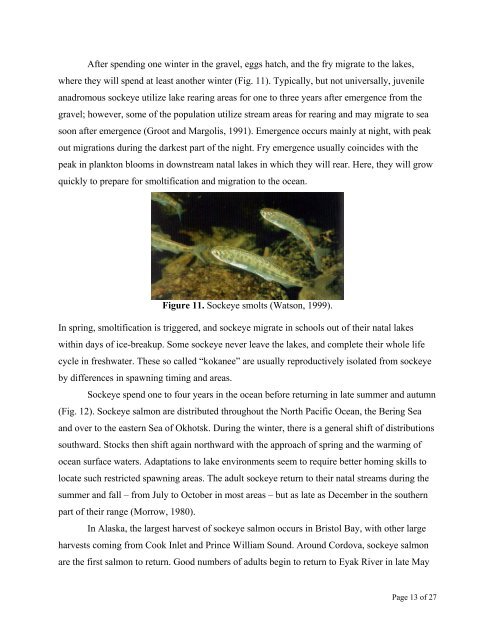Life Histories and Distributions of Copper River Fishes (.pdf)
Life Histories and Distributions of Copper River Fishes (.pdf)
Life Histories and Distributions of Copper River Fishes (.pdf)
You also want an ePaper? Increase the reach of your titles
YUMPU automatically turns print PDFs into web optimized ePapers that Google loves.
After spending one winter in the gravel, eggs hatch, <strong>and</strong> the fry migrate to the lakes,where they will spend at least another winter (Fig. 11). Typically, but not universally, juvenileanadromous sockeye utilize lake rearing areas for one to three years after emergence from thegravel; however, some <strong>of</strong> the population utilize stream areas for rearing <strong>and</strong> may migrate to seasoon after emergence (Groot <strong>and</strong> Margolis, 1991). Emergence occurs mainly at night, with peakout migrations during the darkest part <strong>of</strong> the night. Fry emergence usually coincides with thepeak in plankton blooms in downstream natal lakes in which they will rear. Here, they will growquickly to prepare for smoltification <strong>and</strong> migration to the ocean.Figure 11. Sockeye smolts (Watson, 1999).In spring, smoltification is triggered, <strong>and</strong> sockeye migrate in schools out <strong>of</strong> their natal lakeswithin days <strong>of</strong> ice-breakup. Some sockeye never leave the lakes, <strong>and</strong> complete their whole lifecycle in freshwater. These so called “kokanee” are usually reproductively isolated from sockeyeby differences in spawning timing <strong>and</strong> areas.Sockeye spend one to four years in the ocean before returning in late summer <strong>and</strong> autumn(Fig. 12). Sockeye salmon are distributed throughout the North Pacific Ocean, the Bering Sea<strong>and</strong> over to the eastern Sea <strong>of</strong> Okhotsk. During the winter, there is a general shift <strong>of</strong> distributionssouthward. Stocks then shift again northward with the approach <strong>of</strong> spring <strong>and</strong> the warming <strong>of</strong>ocean surface waters. Adaptations to lake environments seem to require better homing skills tolocate such restricted spawning areas. The adult sockeye return to their natal streams during thesummer <strong>and</strong> fall – from July to October in most areas – but as late as December in the southernpart <strong>of</strong> their range (Morrow, 1980).In Alaska, the largest harvest <strong>of</strong> sockeye salmon occurs in Bristol Bay, with other largeharvests coming from Cook Inlet <strong>and</strong> Prince William Sound. Around Cordova, sockeye salmonare the first salmon to return. Good numbers <strong>of</strong> adults begin to return to Eyak <strong>River</strong> in late MayPage 13 <strong>of</strong> 27
















